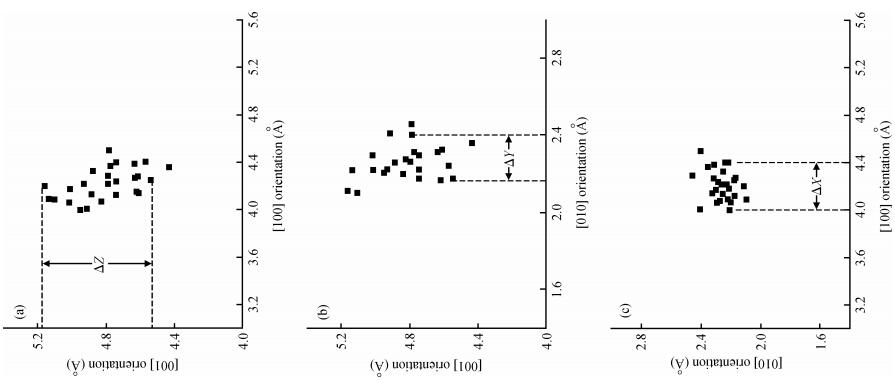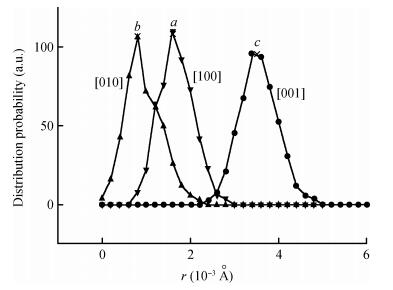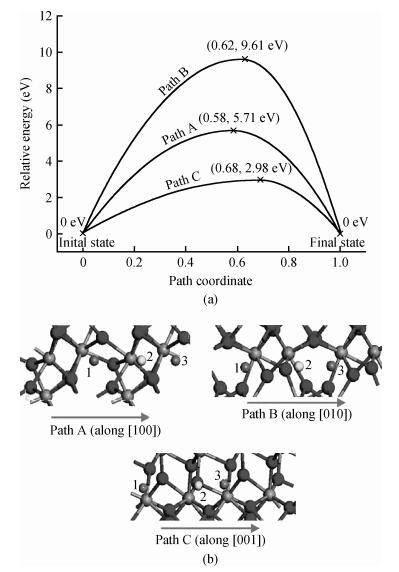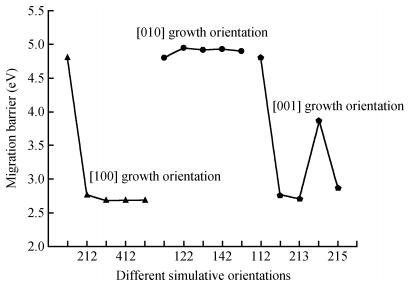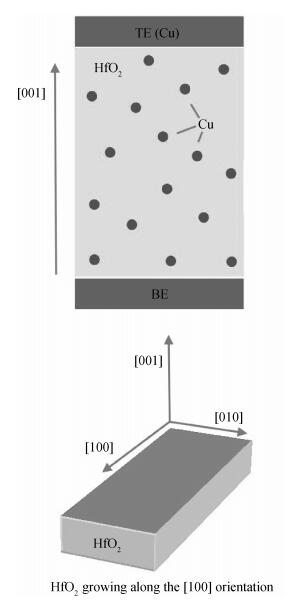| Citation: |
Jinlong Lu, Jing Luo, Hongpeng Zhao, Jin Yang, Xianwei Jiang, Qi Liu, Xiaofeng Li, Yuehua Dai. Optimal migration route of Cu in HfO2[J]. Journal of Semiconductors, 2014, 35(1): 013001. doi: 10.1088/1674-4926/35/1/013001
****
J L Lu, J Luo, H P Zhao, J Yang, X W Jiang, Q Liu, X F Li, Y H Dai. Optimal migration route of Cu in HfO2[J]. J. Semicond., 2014, 35(1): 013001. doi: 10.1088/1674-4926/35/1/013001.
|
-
Abstract
The movement of Cu in a HfO2-based resistive random access memory (RRAM) device is investigated in depth by first-principle calculations. Thermodynamics analysis shows that the dominant motion of Cu tends to be along the[001] orientation with a faster speed. The migration barriers along different routes are compared and reveal that the[001] orientation is the optimal migration route of Cu in HfO2, which is more favorable for Cu transportation. Furthermore, the preferable HfO2 growth orientation along[100], corresponding to Cu migration along[001], is also observed. Therefore, it is proposed that the HfO2 material should grow along[100] and the operating voltage should be applied along[001], which will contribute to the improvement of the response speed and the reduction of power consumption of RRAM.-
Keywords:
- HfO2,
- RRAM,
- Cu migration,
- lattice orientation,
- migration speed
-
References
[1] Zhuang W W, Pan W, Ulrich B D, et al. Novell colossal magnetoresistive thin film nonvolatile resistance random access memory (RRAM). IEDM Tech Dig, 2002:193[2] Baek I G, Lee M S, Seo S, et al. Highly scalable non-volatile resistive memory using simple binary oxide driven by asymmetric unipolar voltage pulses. IEDM Tech Dig, 2004:578[3] Lee D, Choi H, Sim H, et al. Resistance switching of the nonstoichiometric zirconium oxide for nonvolatile memory applications. IEEE Electron Device Lett, 2005, 26(10):719 doi: 10.1109/LED.2005.854397[4] Lin C Y, Wu C Y, Wu C Y, et al. Effect of top electrode material on resistive switching properties of ZrO2 film memory devices. IEEE Electron Device Lett, 2007, 28(5):366 doi: 10.1109/LED.2007.894652[5] Guan W H, Long S B, Liu Qi, et al. Nonpolar nonvolatile resistive switching in Cu doped ZrO2. IEEE Electron Device Lett, 2008, 29(5):434 doi: 10.1109/LED.2008.919602[6] Liu Qi, Long Shibing, Lv Hangbing, et al. Controllable growth of nanoscale conductive filaments in solid-electrolyte-based ReRAM by using a metal nanocrystal covered bottom electrode. ACS Nano, 2010, 4(10):6162 doi: 10.1021/nn1017582[7] Wang Yan, Liu Qi, Lü Hangbing, et al. Improving the electrical performance of resistive switching memory using doping technology. Chinese Science Bulletin, 2012, 57(11):1235 doi: 10.1007/s11434-011-4930-0[8] Yang Yuchao, Pan Feng, Liu Qi, et al. Fully room-temperature-fabricated nonvolatile resistive memory for ultrafast and high-density memory application. Nano Lett, 2009, 9(4):1636 doi: 10.1021/nl900006g[9] Wang Yan, Liu Qi, Long Shibing, et al. Investigation of resistive switching in Cu-doped HfO2 thin film for multilevel non-volatile memory applications. Nanotechnology, 2010, 21(4):045202 doi: 10.1088/0957-4484/21/4/045202[10] Lv Hangbing, Wan Haijun, Tang Tingao. Improvement of resistive switching uniformity by introducing a thin GST interface layer. IEEE Electron Device Lett, 2010, 31(9):978 doi: 10.1109/LED.2010.2055534[11] Wang Zhongrui, Zhu W G, Du A Y, et al. Highly uniform, self-compliance, and forming-free ALD HfO2-based RRAM with Ge doping. IEEE Trans Electron Devices, 2012, 59(4):1203 doi: 10.1109/TED.2012.2182770[12] Gao B, Zhang H W, Yu S, et al. Oxide-based RRAM:uniformity improvement using a new material-oriented methodology. VLSI Technology, 2009:30[13] Umezawa N, Sato M, Shiraishi K. Reduction in charged defects associated with oxygen vacancies in Hafnia by magnesium incorporation:first-principles study. Appl Phys Lett, 2008, 93(22):223104 doi: 10.1063/1.3040306[14] Kasai H, Aspera S M, Kishi H, et al. First principles study on the switching mechanism in resistance random access memory devices. Simulation of Semiconductor Processes and Devices, 2011:211[15] Zhao Qiang, Zhou Maoxiu, Zhang Wei, et al. Effects of interaction between defects on the uniformity of doping HfO2-based RRAM:a first principle study. Journal of Semiconductors, 2013, 34(3):032001 doi: 10.1088/1674-4926/34/3/032001[16] Zhang Wei, Hou Z F. Interaction and electronic structures of oxygen divacancy in HfO2. Physica Status Solidi B, 2012, 250(2):352[17] Li Yingtao, Long Shibing, Zhang Manhong, et al. Resistive switching properties of Au/ZrO2/Ag structure for low-voltage nonvoatile memory applications. IEEE Electron Device Lett, 2010, 31(2):117 doi: 10.1109/LED.2009.2036276[18] Segall M D, Lindan P J D, Probert M J, et al. First principles simulation:ideas, illustrations and the CASTEP code. J Phys Condens Matter, 2002, 14:2717 doi: 10.1088/0953-8984/14/11/301[19] Gu T, Tomofumi T, Satoshi W. Conductive path formation in the Ta2O5 atomic switch:first-principles analyses. ACS Nano, 2010, 4(11):6477 doi: 10.1021/nn101410s[20] Hann R E, Suitc P R, Penteco J L. Monoclinic crystal structures of ZrO2 and HfO2 refined from X-ray powder diffraction. Data J Am Ceram Soc, 1985, 68(10):285[21] Shuichi N. A molecular dynamics method for simulations in the canonical ensemble. Molecular Physics, 1984, 52(2):255 doi: 10.1080/00268978400101201[22] Baron P, Liang W, Bell A T. Biasing a transition state search to locate multiple reaction pathways. J Chem Phys, 2003, 118(21):9533 doi: 10.1063/1.1569906[23] Khan M S, Islam M S. Dopant substitution and ion migration in the LaGaO3-based oxygen ion conductor. J Mater Chem B, 1998, 102(17):3099[24] Julian R T, Saiful I M, Slater P R. Defect chemistry and oxygen ion migration in the apatite-type materials La9.33Si6O26 and La8Sr2Si6O26. J Mater Chem, 2003, 13:1956 doi: 10.1039/b302748c[25] Sakib K M, Saiful I M, Bates D R. Cation doping and oxygen diffusion in zirconia:a combined atomistic simulation and molecular dynamics study. J Mater Chem, 1998, 8:2299 doi: 10.1039/a803917h[26] Saiful M I. Ionic transport in ABO3 perovskite oxides:a computer modelling tour. J Mater Chem, 2000, 10:1027 doi: 10.1039/a908425h -
Proportional views






 DownLoad:
DownLoad:

